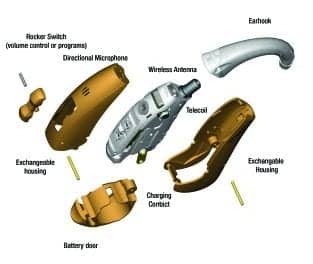 |
In recent years, the hearing industry has introduced a variety of exciting technologies and products that appeal to a younger audience of hearing aid users who have milder hearing losses. With the “rediscovery” of open-ear fittings, which started their modern incarnation with the ReSoundAir device in 2003, an entirely new class of mini-BTEs has presented consumers with a host of more palatable options, not the least of which is a reduction in age-old industry “side effects” like occlusion and cosmetic/stigma issues. Closely following were the receiver-in-the-ear (RITE) products, spearheaded by Sebotek in 2004, that combined the advantages of deeper canal fittings with the many features of BTEs. The wireless revolution that is now sweeping every industry—from computer networks to household appliances—is putting an exclamation mark on the “communication aspect” of our industry’s products. In short, wireless technology is a booming voice reminding us of the fact that we’re in the communication business, not just the business of compensating for hearing loss.
Few would argue that all these technical advances and product introductions can be seen as good news. However, even with these advances, a significant number of consumers will still be sitting on their hands before taking the leap to better hearing. The data reported by Sergei Kochkin, PhD, in MarkeTrak VII (July 2005 HR), which reflects consumers’ responses to survey questions, show that the overall hearing aid adoption rate (ie, those people with a “significant hearing loss” who own a hearing instrument) is only 23.5%. However, for those people ages 85+ and 75-84, the adoption rate is 61% and 44%, respectively. That’s pretty good considering all of the variables in this population. But hearing aid adoption rates decline precipitously as we look at younger age groups. Consumers who are 65 to 74 years old have a hearing aid adoption rate of 31%, and those between the ages of 55 and 64 have an adoption rate of 17%. In fact, MarkeTrak VII indicates that the average hearing aid purchaser is 70 years old, while US Census Bureau data indicate that average life expectancy is 78! Bottom line: For typical consumers, we’re not reaching them until most of their hearing is gone and they are in their last years of life.
Assistive devices and hearing conservation products are two fascinating areas where we could truly advance the message that hearing care is not just for older people; hearing care is for life. These products generally take a backseat to dispensing professionals’ (and, yes, the trade media’s) fascination with hearing aids. In many cases, dispensing offices don’t even mention or offer them to consumers.
Earplugs, musicians’ plugs, and swimplugs demonstrate that dispensing professionals are genuinely concerned about the actual health and maintenance of the patient’s auditory system. Their value is fairly apparent to anyone who has ever attended a rock concert or car race, played in a band, or pushed a lawnmower around the yard.
Assistive devices, by contrast, might be seen as a first step for those people who didn’t have earplugs when they attended a rock concert or car race, played in a band, or pushed a lawnmower around the yard. In particular, TV and stereo listening systems, amplified telephones, and similar products represent an ideal bridge to ease people into the hearing help cycle—ultimately leading to earlier and more successful intervention and improved quality of life for the consumer. Additionally, they may fill gaps when a hearing aid “just isn’t enough.”
With open-fit and RITE mini BTEs, as well as wireless communication options, the hearing care field is in better shape than ever to address the needs of younger people with milder losses. However, we can’t forget that hearing conservation products and assistive devices remain a vital component in our overall goal to address the comprehensive needs of consumers.
Karl Strom
Editor-In-Chief




